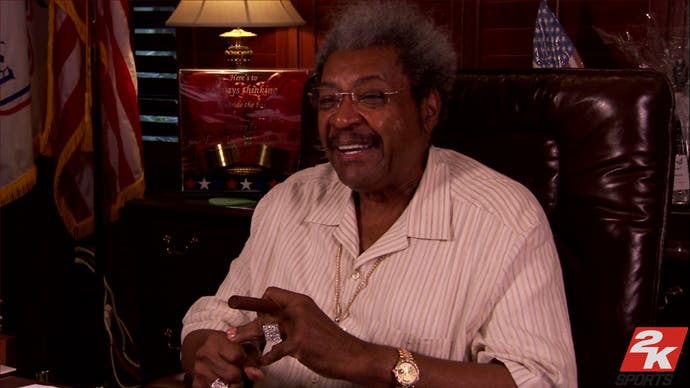Don King Presents: Prizefighter
Don and dusted.
It all sounds flexible, but it's not terribly. Movement around the ring is slow, combos are difficult to build up, the jab is very weak, and a fighter's reach is virtually insignificant. Heavy hitting is key. Collision detection is poor, which is pretty fatal for a contact sport where the level of contact decides the winner. The single-player AI is also susceptible to particular tactics or repeated bursts of the same attack. It's rarely so clear-cut that you can shortcut an entire bout, but you'll welcome the opportunity to hammer an opponent with the same left-side body blow over and over again when it's presented.
You can almost always get the first punch in when the bell sounds, too, which coupled with a stored "signature" move gives you the upper hand - and potentially a knockout in the latter stages of the fight. Signature moves are Prizefighter's heaviest hits: an adrenaline bar, which lives below health and stamina in the bottom corner of the screen, fills up as you grow into the fight. When it starts flashing you can hold the left bumper and press an attack button to unleash a more powerful punch. If it connects, which isn't certain, the other guy drops a big chunk from his orange bar.
Outside the ring, things are quite rudimentary. Beyond the snazzy documentary sequences, Career mode is basically three main screens: a PDA for reading messages from your promoter, who will try and get you to ditch training to do some publicity (not interactive, sadly - we quite fancied going mad at a book launch), a screen for booking fights with anyone in the current tier of half a dozen, and a training area.
The training games are the only other gameplay, and cover heavy bag and speed bag work, jump rope, focus mitts and shuttle running. The mechanics are a mixture of button-matching and button-mashing. Some of it's quite manic, and there are leaderboards to challenge your PBs, but there's also an auto-train button that saves you the hassle and still upgrades your stats a bit. Oddly for a game about becoming the best boxer in the world, produced by Don King, the only advice you get on improving or adapting your technique is from throwaway clichés tossed around by the trainer before and between bouts.

It's not all fighting and training and watching TV though, because there's also some more fighting. To help break up the pace, your trainer sometimes plonks himself on the couch in your office-cum-menu-screen, and tells you how something you're facing reminds him of the good old days. The game then flashes back to whichever fight he's remembering (Braddock versus Baer in the 30s, for instance), applies a sepia tint, and gives you a mountain to climb. These one-off bouts might give you a busted left hand to contend with, or just ask you to survive to the end of the round against a superior fighter, exaggerating handicaps that are also put to dramatic use in Career.
Which just leaves multiplayer. We couldn't do too much of this at the time of writing because Prizefighter wasn't out, but the few bouts we did play through were fine, performance-wise. The issue was that, while you can select from a few dozen licensed boxers (including Joe Calzaghe, Chris Eubank and Rocky Marciano), quirks of Prizefighter's combat mean they can't be relied upon to be strong in the ways they are in real life. And that the combat's not very entertaining.

It's not that it's bad, particularly. To some extent it suffers from selective authenticity. Ten two-minute rounds against a tough opponent can be tight, tense and technical, but the skills you're applying are arbitrary: not hammering the buttons impatiently, which often buffers one more punch than you want to throw; pressing your advantage when your opponent starts yielding to an obvious sequence, like three left hooks to break his guard and an uppercut to land a free hit; saving up a signature attack for the free first hit at the start of the next round. You might as well be learning any game's system, or how to ask the way to the post office in Belgium. You get knocked down too often, and so does the other guy. It's not really boxing, and you know it.
That said, casual gamers will gradually reach a compromise with Prizefighter's quirks that allows them to enjoy it - in much the same way football fans used to enjoy FIFA when it was basically on rails, but a bit limited. Sports games are never realistic (unless you count Wii Fit), but the difference between the likes of modern FIFA, Fight Night and this is that their mechanics were fun to learn with suitable on-screen rewards. Prizefighter is too clunky and gruelling to qualify for the same praise, and all the high-def cut-scenes in the world can't make up for that.








